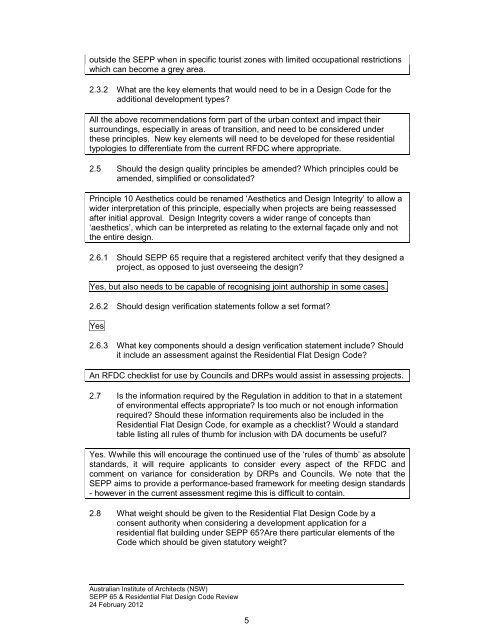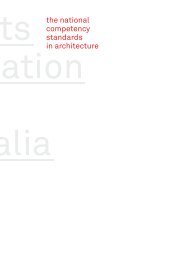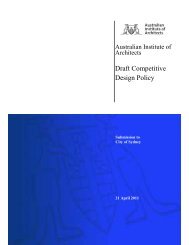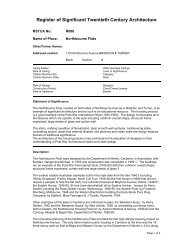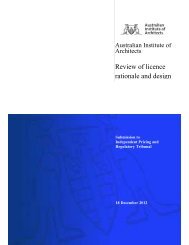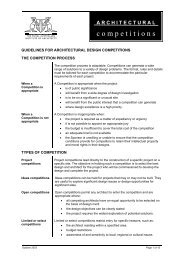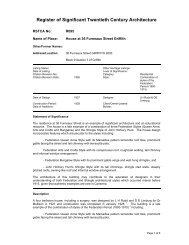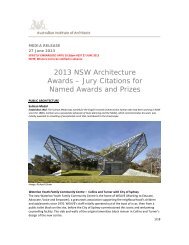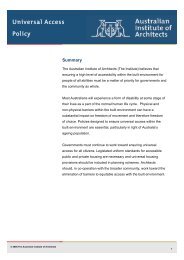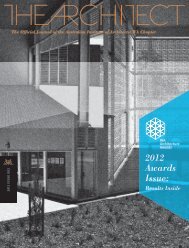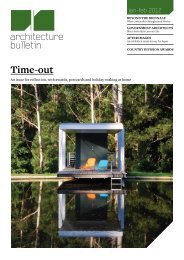SEPP 65 & Residential Flat Design Code Review - Australian ...
SEPP 65 & Residential Flat Design Code Review - Australian ...
SEPP 65 & Residential Flat Design Code Review - Australian ...
Create successful ePaper yourself
Turn your PDF publications into a flip-book with our unique Google optimized e-Paper software.
outside the <strong>SEPP</strong> when in specific tourist zones with limited occupational restrictionswhich can become a grey area.2.3.2 What are the key elements that would need to be in a <strong>Design</strong> <strong>Code</strong> for theadditional development types?All the above recommendations form part of the urban context and impact theirsurroundings, especially in areas of transition, and need to be considered underthese principles. New key elements will need to be developed for these residentialtypologies to differentiate from the current RFDC where appropriate.2.5 Should the design quality principles be amended? Which principles could beamended, simplified or consolidated?Principle 10 Aesthetics could be renamed ‘Aesthetics and <strong>Design</strong> Integrity’ to allow awider interpretation of this principle, especially when projects are being reassessedafter initial approval. <strong>Design</strong> Integrity covers a wider range of concepts than‘aesthetics’, which can be interpreted as relating to the external façade only and notthe entire design.2.6.1 Should <strong>SEPP</strong> <strong>65</strong> require that a registered architect verify that they designed aproject, as opposed to just overseeing the design?Yes, but also needs to be capable of recognising joint authorship in some cases.2.6.2 Should design verification statements follow a set format?Yes2.6.3 What key components should a design verification statement include? Shouldit include an assessment against the <strong>Residential</strong> <strong>Flat</strong> <strong>Design</strong> <strong>Code</strong>?An RFDC checklist for use by Councils and DRPs would assist in assessing projects.2.7 Is the information required by the Regulation in addition to that in a statementof environmental effects appropriate? Is too much or not enough informationrequired? Should these information requirements also be included in the<strong>Residential</strong> <strong>Flat</strong> <strong>Design</strong> <strong>Code</strong>, for example as a checklist? Would a standardtable listing all rules of thumb for inclusion with DA documents be useful?Yes. Wwhile this will encourage the continued use of the ‘rules of thumb’ as absolutestandards, it will require applicants to consider every aspect of the RFDC andcomment on variance for consideration by DRPs and Councils. We note that the<strong>SEPP</strong> aims to provide a performance-based framework for meeting design standards- however in the current assessment regime this is difficult to contain.2.8 What weight should be given to the <strong>Residential</strong> <strong>Flat</strong> <strong>Design</strong> <strong>Code</strong> by aconsent authority when considering a development application for aresidential flat building under <strong>SEPP</strong> <strong>65</strong>?Are there particular elements of the<strong>Code</strong> which should be given statutory weight?<strong>Australian</strong> Institute of Architects (NSW)<strong>SEPP</strong> <strong>65</strong> & <strong>Residential</strong> <strong>Flat</strong> <strong>Design</strong> <strong>Code</strong> <strong>Review</strong>24 February 20125


